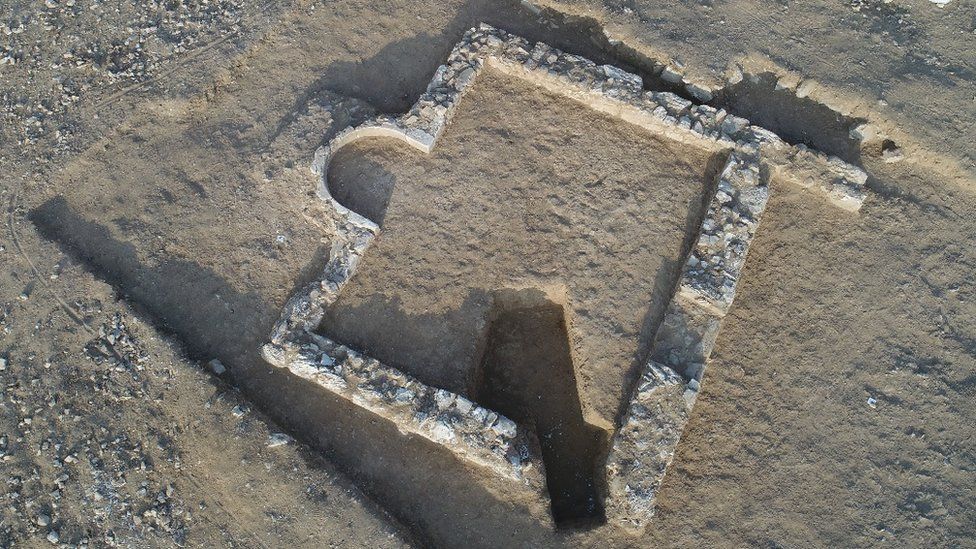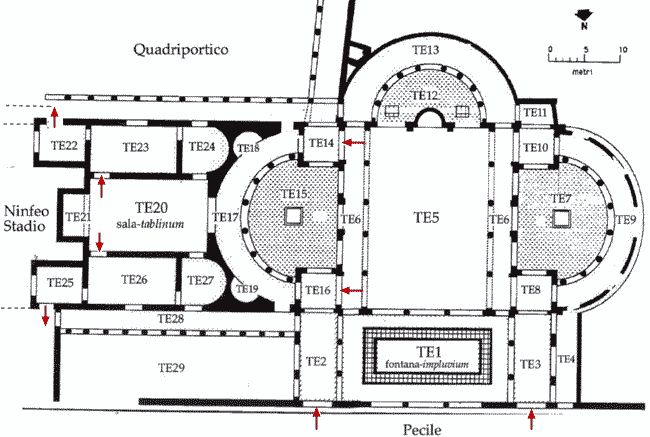I think Diocle's critiques are valid. What can be said is that the structure's form, date, and orientation are consistent with it having been a small mosque, rather than saying that it is a mosque.
Regarding its orientation. The researchers are saying it is to the south in the press release, however I can see in the pictures that it is facing a bit to the southeast. We could say roughly south-southeast. The reason I know that is because the initial cuts that were made into the ground (those that form the bulks of the excavation) would have been made along a string (tensioned by stakes) aligned precisely north to south and east to west with the help of GPS and modern surveying equipment. South-southeast is actually more toward Mecca than south. But then I have to ask, if anyone knows, by what method did the Romans align their cities north to south? I'm assuming it was not as accurate as can be done with GPS and modern surveying equipment. If you look at the shadows in the pictures, you can see that if they were simply using the sun, they would have thought they were orienting the building directly south rather than toward Mecca.
Regarding circular reasoning in archaeology, it isn't anything new or postmodern, rather it seems to be an easy mistake to fall into when building upon other's assumptions as solid fact...
An example is the case of the so-called Solomonic gates:


For decades, and to this day in some circles, these were referred to as Solomonic gates, due to the fact that it was "known" that this form of gate originated with the great construction projects of Solomon. According to 1 Kings 9:15, Solomon built the the walls of Hazor, Megiddo, and Gezer, and sure enough, all three cities had similar gates dated stratigraphically to the same period. William Dever who excavated the gate at Gezer was the first to notice the pattern in the 1960s, and that all three gates dated to the time of Solomon's reign, or so it was believed. That was until Israel Finkelstein (one of my main mentors in archaeology) came along an shook things up. Finkelstein argued that the gates all dated to a century later, during the reigns of Omri and Ahab, that similar gates in Syria predated the form, and that the entire accepted absolute chronology being used in the Levant was off by a century because the Bible was being accepted uncritically.
This upset a lot of archaeologists who didn't consider themselves the types to accept the Bible uncritically. They protested that it was the archaeology that corroborated 1 Kings 9:15, not the other way around, because all the gates dated to the reign of Solomon. The issue is that stratigraphy can only provide a relative chronology, it has to be anchored to historical events in order to turn it into an absolute chronology. Scientific dating methods like C-14 can help narrow things down, but they have a wide margin of error for various reasons. The range of possibility they provide is often not as focused as what we would like for historical purposes. At the time Finkelstein came along with his new "low chronology" challenge, everyone thought he was being pointlessly contrary (at best), because the relative chronology was anchored to numerous historical events. The gates were dated to the reign of Solomon by stratigraphy, the stratigraphy was dated by pottery horizons, the pottery horizons were dated to historical anchors.
So what is a historical anchor? The destruction of a city in the historical record is a good example. If you see two destruction layers at a city during the Iron Age, and you know according to the historical record that the city was destroyed by the Assyrians and the Babylonians, you assume the earlier destruction layer can be connected to the Assyrian destruction and the later to the Babylonian destruction, and now you have two absolute dates for these stratigraphic layers, and so you cross-reference the pottery horizons with all the other established anchors in the region to make sure analogous pottery horizons all have similar absolute dates, otherwise some anchor is wrong. But what if you have three destruction layers at the site? Not all destructions make it into the historical record, so you look at the absolute dates determined by other anchors in similar pottery horizons. It may be that your destruction layers are 1) Unknown 2) Assyrian 3) Babylonian or 1) Assyrian 2) Babylonian 3) Unknown, etc. It eventually get works out accurately because there are so many interlocking horizons and anchors, each supporting each other.
So Finkelstein seemed pretty out there challenging this massive matrix of interlocking pottery horizons and anchors, but as Finkelstein discovered, the entire matrix was initially built starting in the early 1900s from an anchor that was an assumption. That is the construction of the gate at Megiddo, which was initially anchored to the reign of Solomon by 1 King 9:15. Prior to the 1990s the absolute chronology of the entire Eastern Mediterranean was wrong. What was happening was that 1 Kings 9:15 was being corroborated by the archaeology because of the Solomonic gates, the Solomonic gates were dated to the reign of Solomon by the stratigraphy, the stratigraphy was dated by the pottery horizons, the pottery horizons were dated by a massive matrix of interlocking historical anchors, the massive matrix historical anchors was built from a foundation that began in the early Twentieth Century, which included the gate at Megiddo, which was anchored to the reign of Solomon by 1 Kings 9:15.









 Reply With Quote
Reply With Quote












































